A First Safari in Namibia
Part II
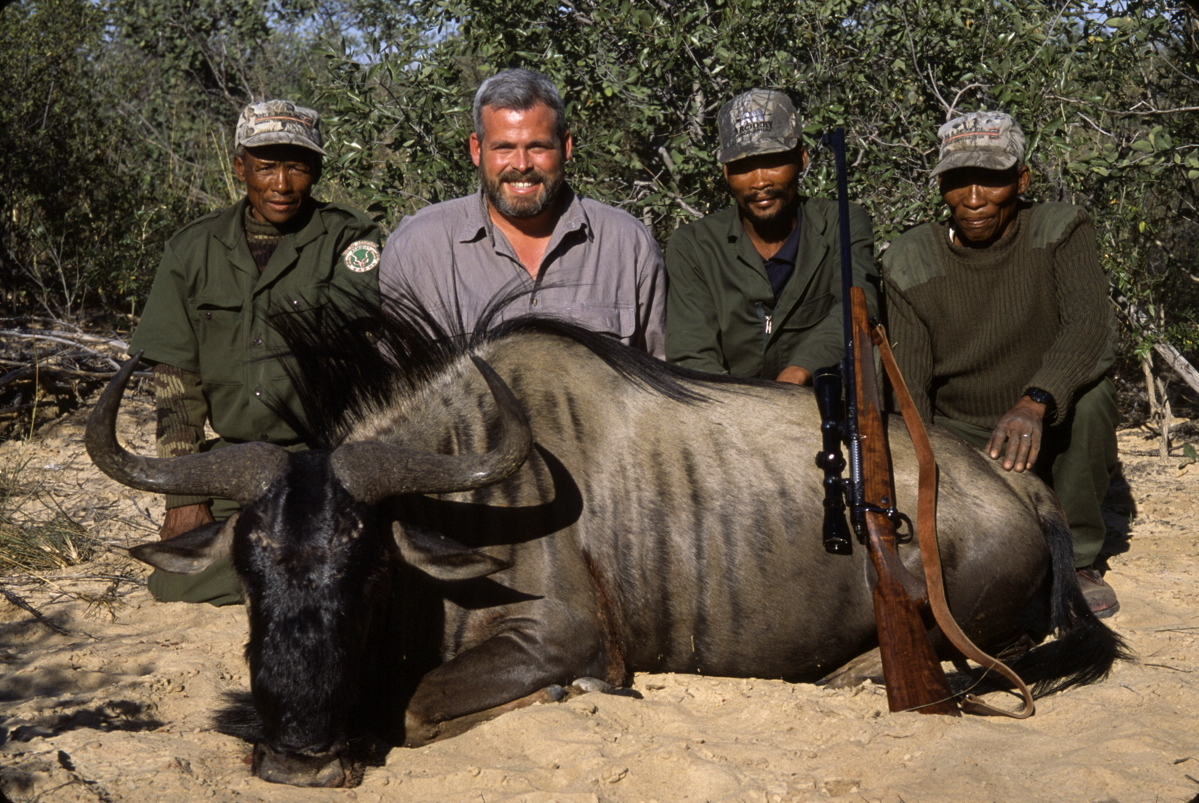
A First Safari in Namibia
|
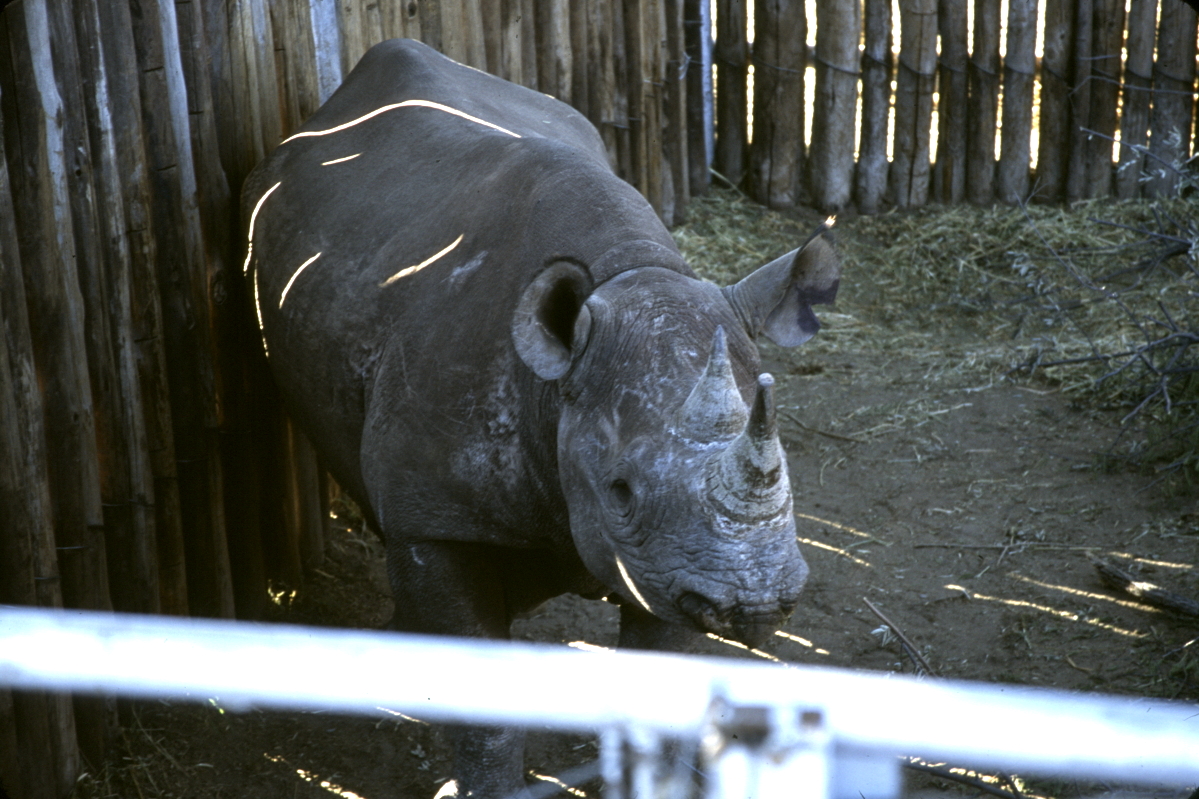
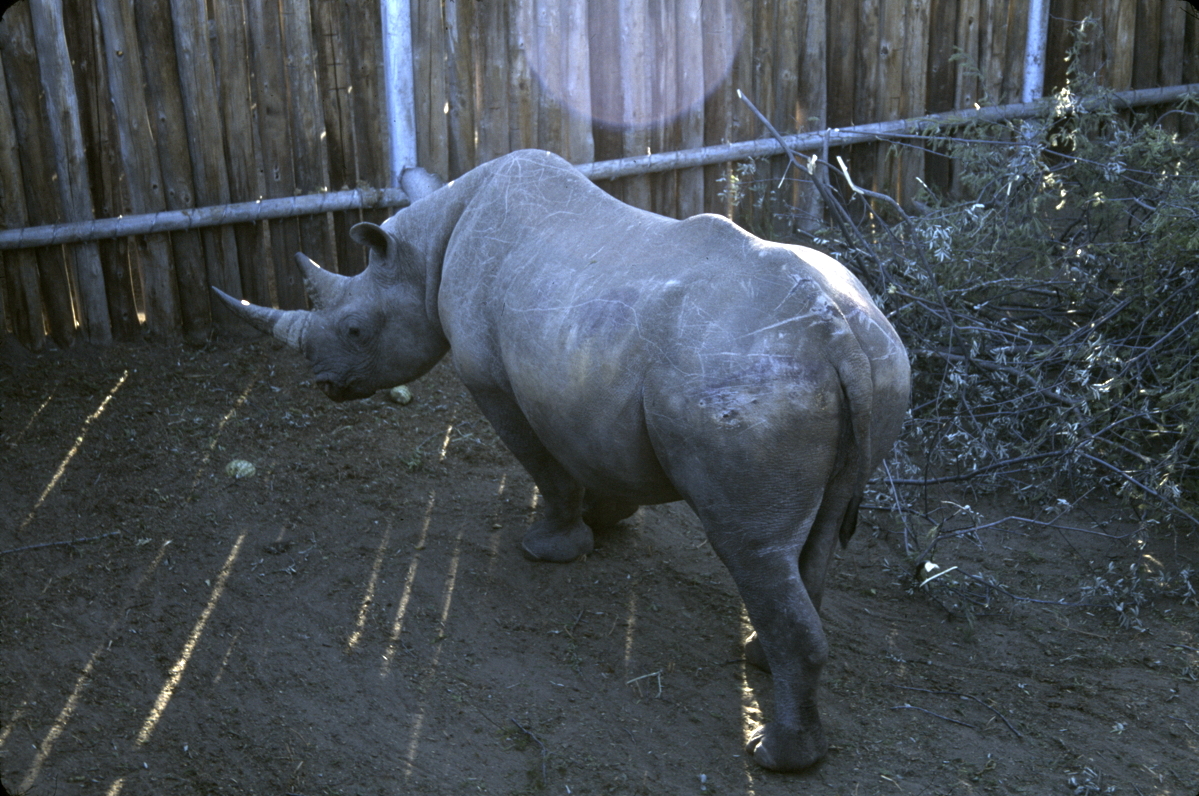 Endangered Black Rhinos in a Holding BomaThese youngsters were our neighbors while we were at Eden. A Namibian game conservation officer named Pierre was supervising the release of four new black rhinos, including an ancient cow which was the sole survivor of the slaughter of the herds in the area ravaged by the UNITA guerrillas. These fellows were only about hip high but already weighed around 1200 to 1500 pounds. The one on the top was "friendly" and liked to have his chin scratched. The other one did not play well with others (and observe how sharp his front horn is!). Rhinos are naturally testy, even with each other. A big male from Eden was already sniffing around these young ones and the worry was that he would kill them. It was thrilling to see these animals and to be a part of helping to ensure their survival. Eden trackers guard and check on the resident rhinos every day, verifying the well-being of each individual at least once a week. Although we saw fresh tracks one morning while hunting impala near camp we never saw any rhinos in the open. You could get quite close to one before you realized your mistake, which makes for a very precarious situation considering that there are few trees that can be climbed and they all bristle with vicious thorns (but better thorned than horned...). |
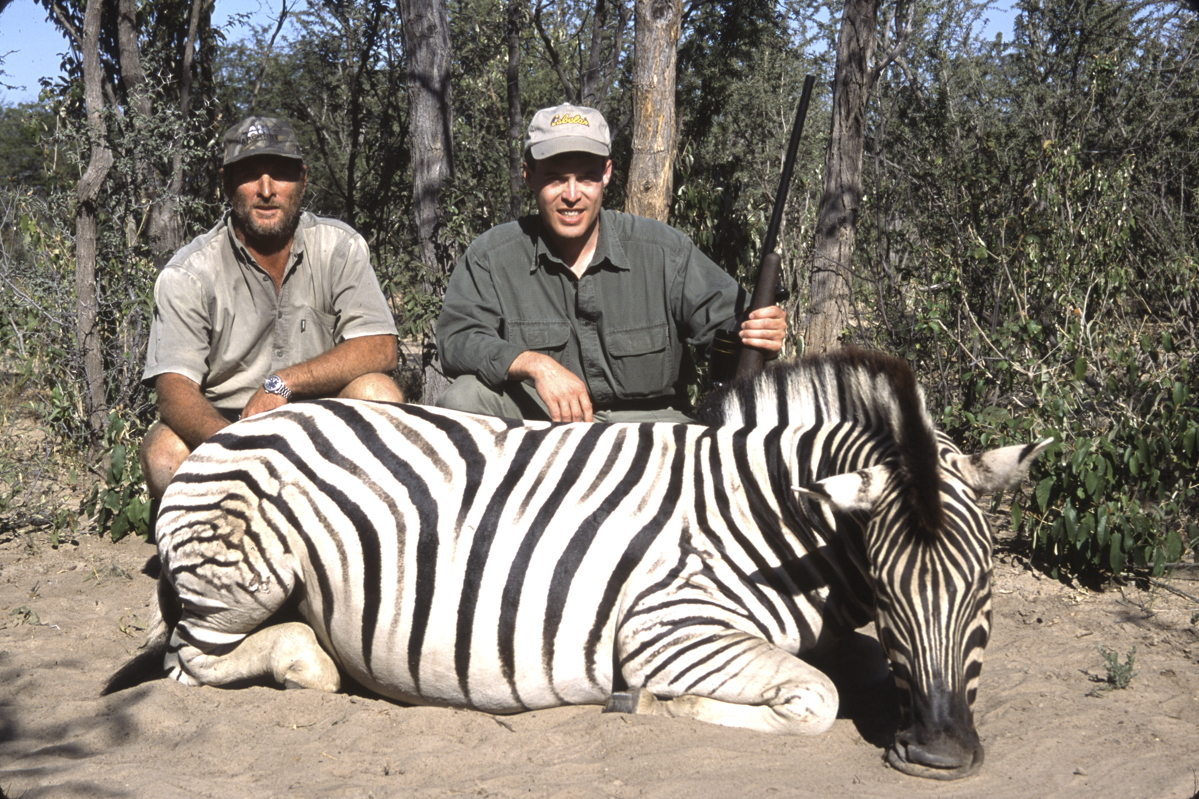 A Lone Zebra StallionThis old bachelor stallion was apparently driven out of the herd by a younger dominant male. We spotted him grazing alone at the far edge of a vast opening, roughly half a mile across. To get the shot Allan and I slunk in a crouching fashion across that broad field until we were about 250 yards distant, when I had to take the shot before the zebra was alerted by a spooked wildebeest. The 225 grain Trophy Bonded Bear Claw sent him tail over teakettle and he was dead almost instantly. This was the first African trophy that I was able to take with my own rifle, a custom re-barreled Remington M700 in .340 Weatherby Magnum, using the excellent Federal Premium Trophy Grade load. |
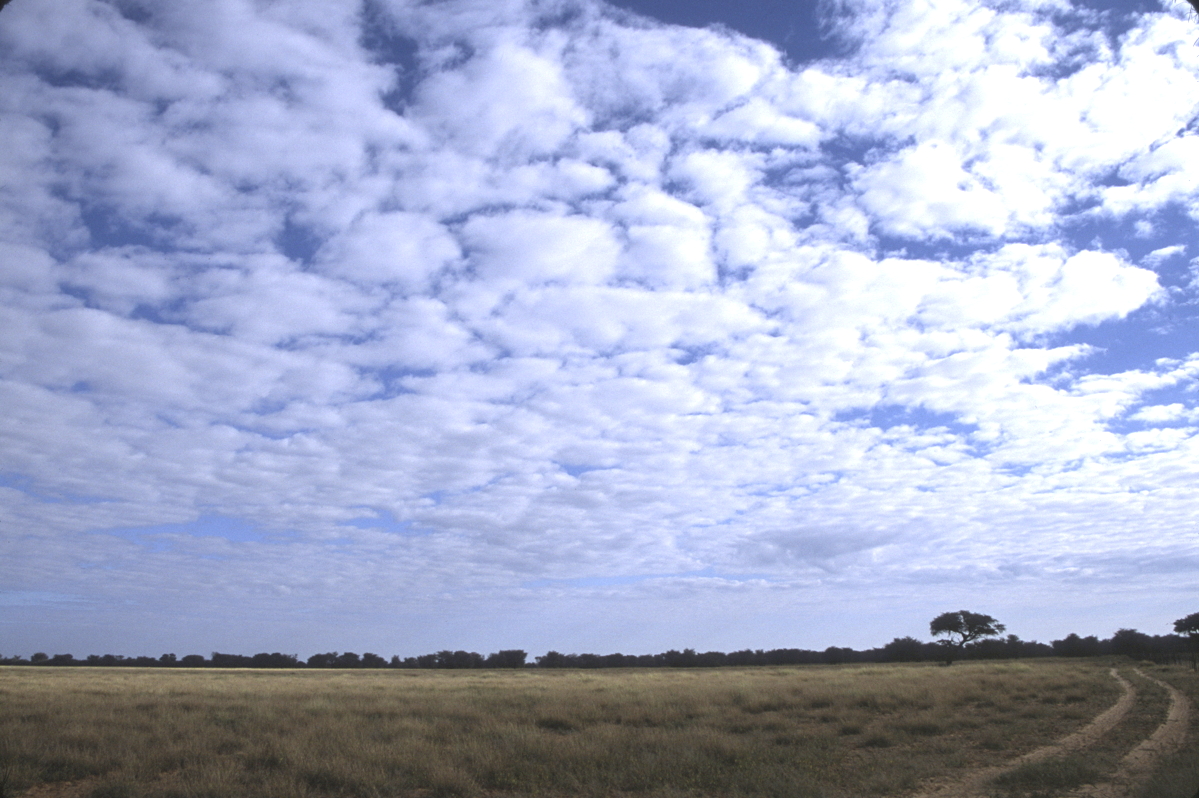 The Open Plains AreaThis clearing in the thorn bush stretched some three miles in length and was over half a mile wide. It was cleared to serve as an airstrip (I believe during the time years ago that this area of rolling sand dunes was mined), but it has become the crossroads for herds of grazing animals including zebra, eland, wildebeest and springbok. This was also about the only open space in the Eden preserve, apart from roads and the Omataku River bed. Almost all of Eden was thorn bush so thick you couldn't see more than a few yards. I shot my zebra in this opening and we also hunted for springbok here. The openness made spotting game easy, but approaching within shooting range was not always so simple. |
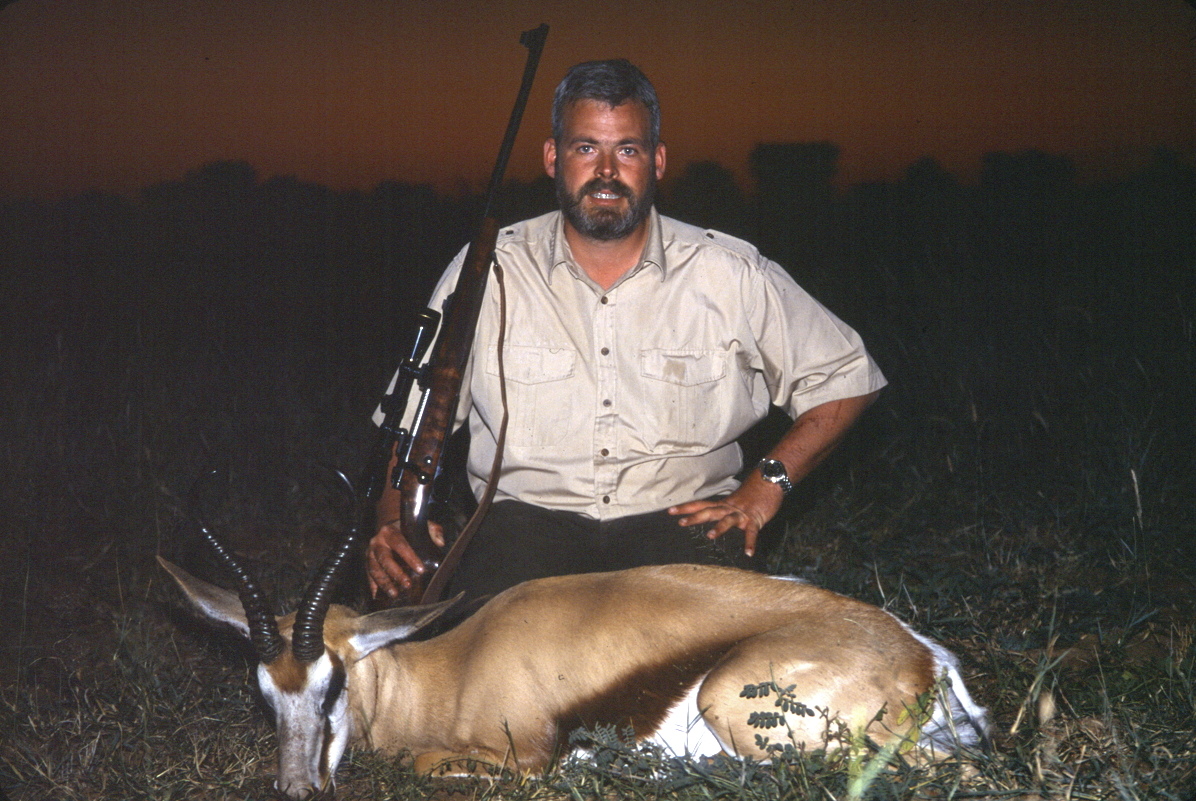
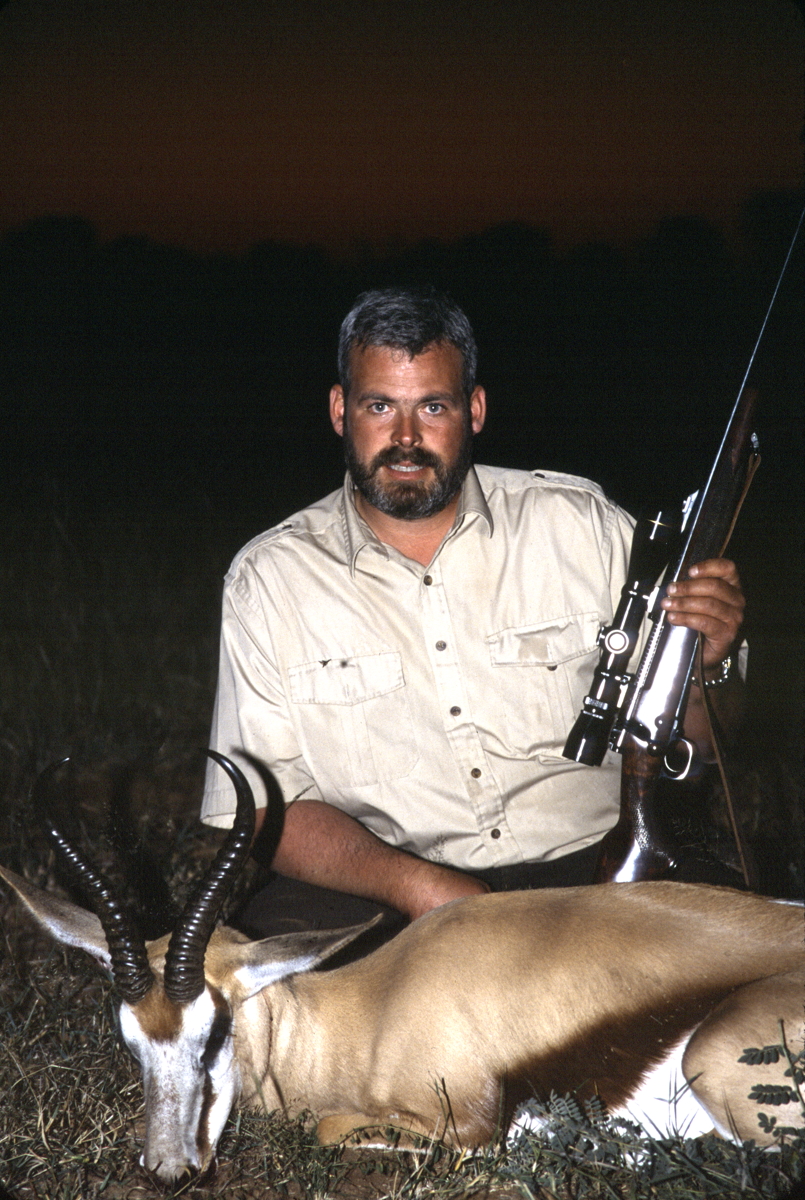
My Brother's Trophy Springbok RamWe trudged over five miles without water in the afternoon heat looking for this ram and caught up with the herd just at dusk. Steve had to shoot in very poor light but managed to nail this excellent 13-1/2 inch ram at over 100 yards. You can just see the ruffed hair on his back which has almost laid back down. This turns inside out exposing a wide blaze of white in alarm, similar to how a whitetail deer uses its tail. |
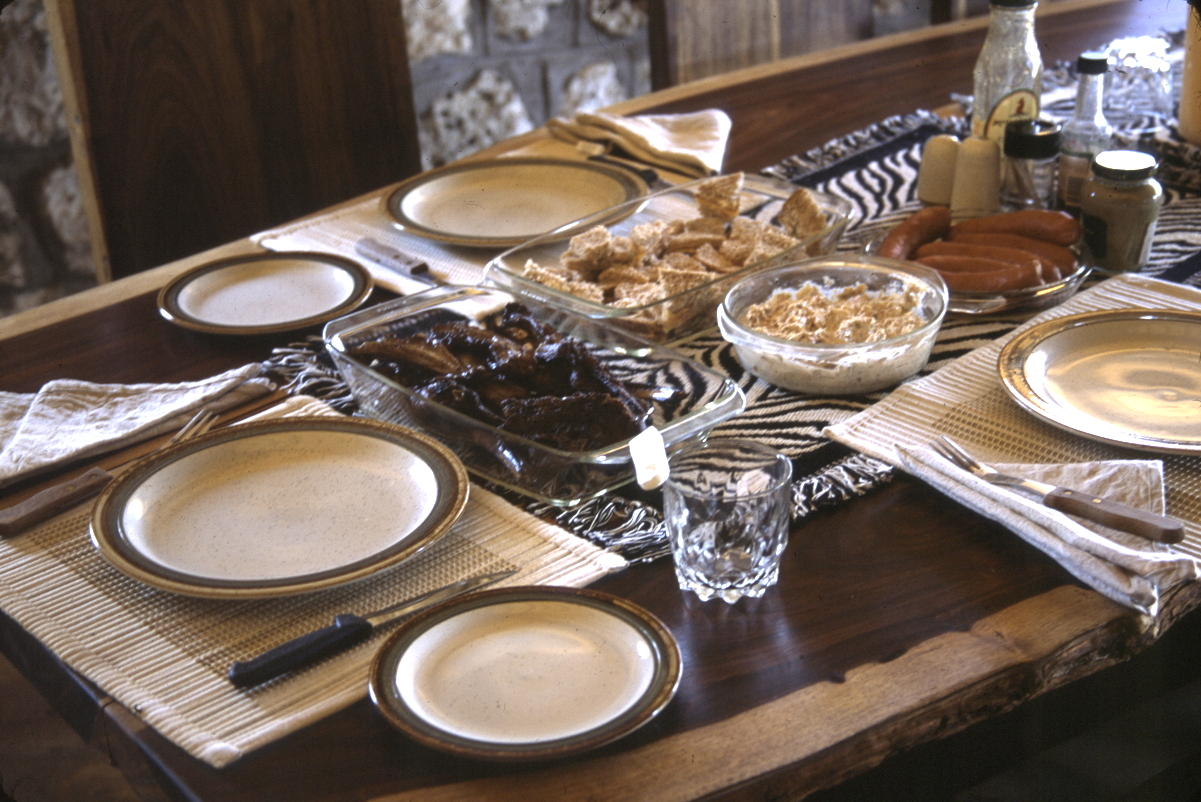
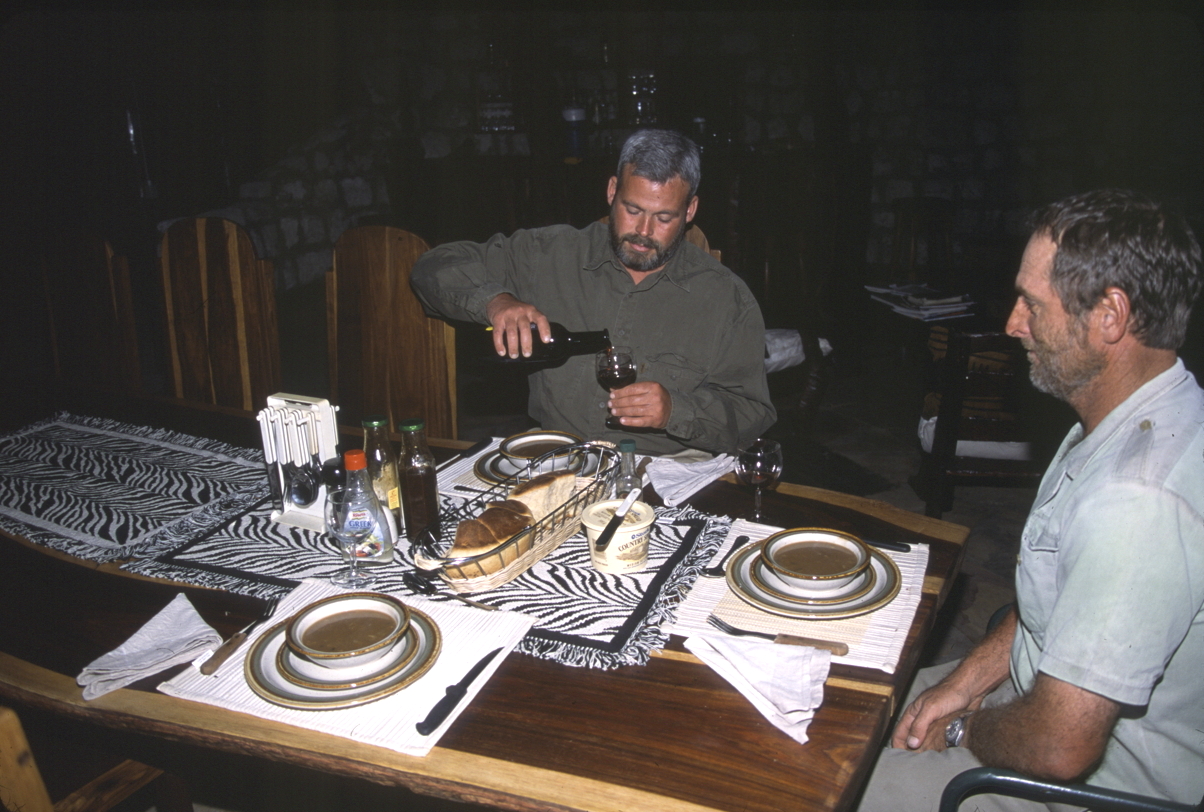 A Typical Lunch and DinnerOur camp chief, Tomas, was also a remarkably accomplished master cook, doubly remarkable for the fact that he performed all his culinary feats over a fire pit. We had freshly baked bread daily, homemade soups, roast eland, gemsbok goulash, curried chicken, wors (game sausages) and a host of salads at lunchtime. Our libations ranged from fresh juice to Tafel lagers and excellent South African wines. Dessert was usually canned guavas with vacuum packed heavy cream or custard. Our favorite local condiments were a very piquant peri-peri sauce and some kind of chutney. |
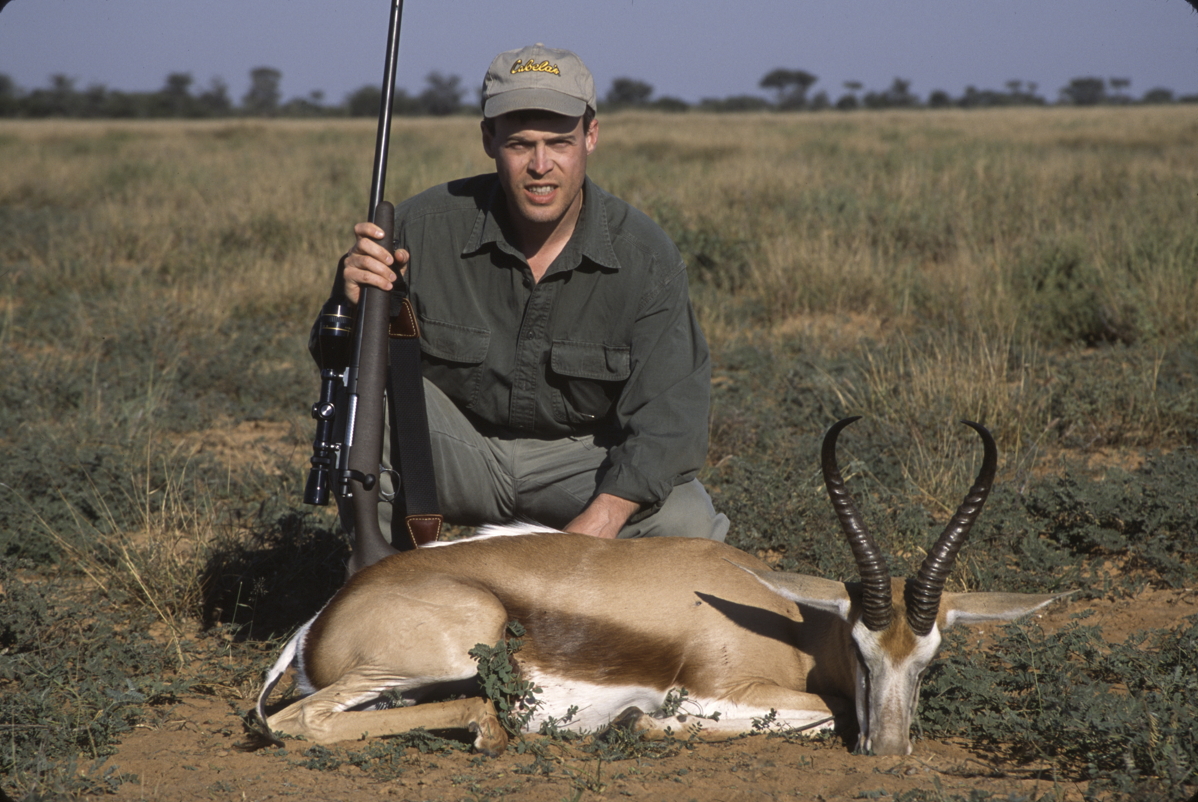 My SpringbokThis ram may have assumed - very briefly - the dominant rank in the herd formerly led by Steve's ram. He went down instantly to a hit too far back that went through the liver and the paunch. After nearly a minute he staggered back up and began grazing in a daze. I more carefully placed a .338-225 grain Bear Claw through the body almost lengthwise, to which impact he did not twitch a muscle (so much for knockdown power!), but he pitched over sideways a few seconds later, by the time I had shucked a round. He has about 14 inch horns and nice thick bases. |
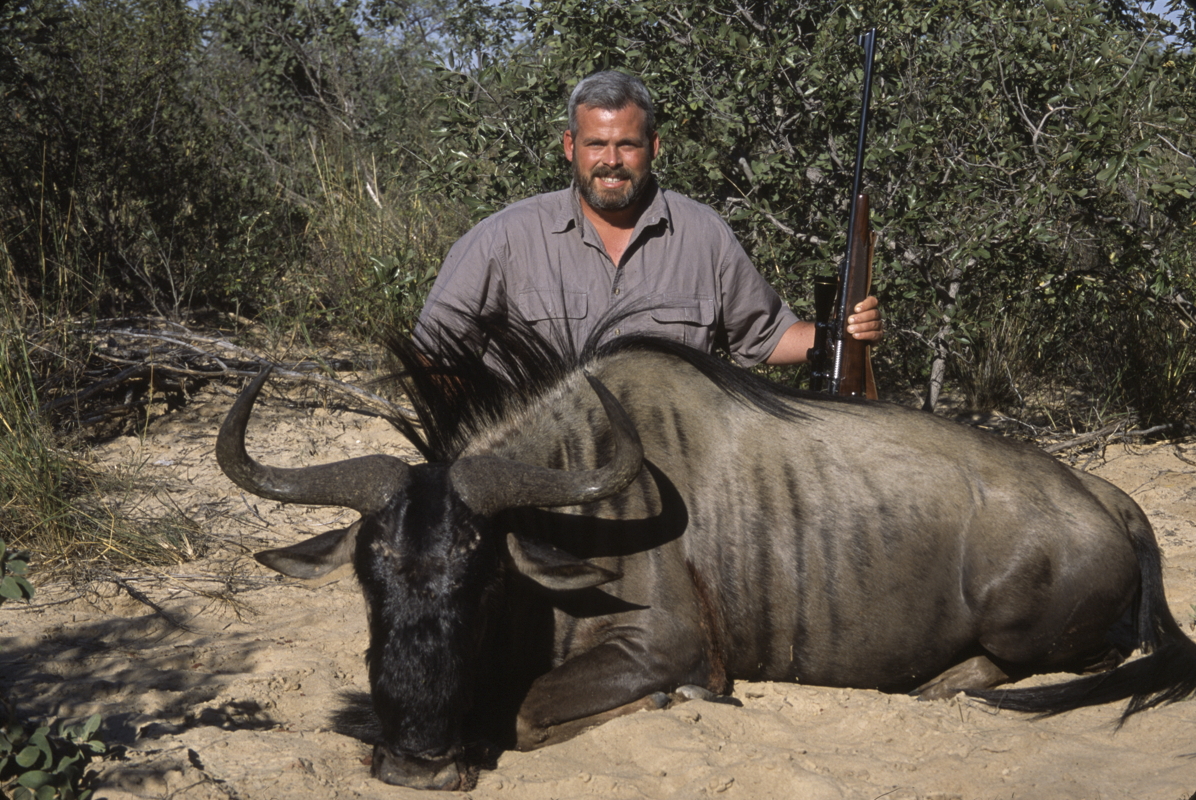
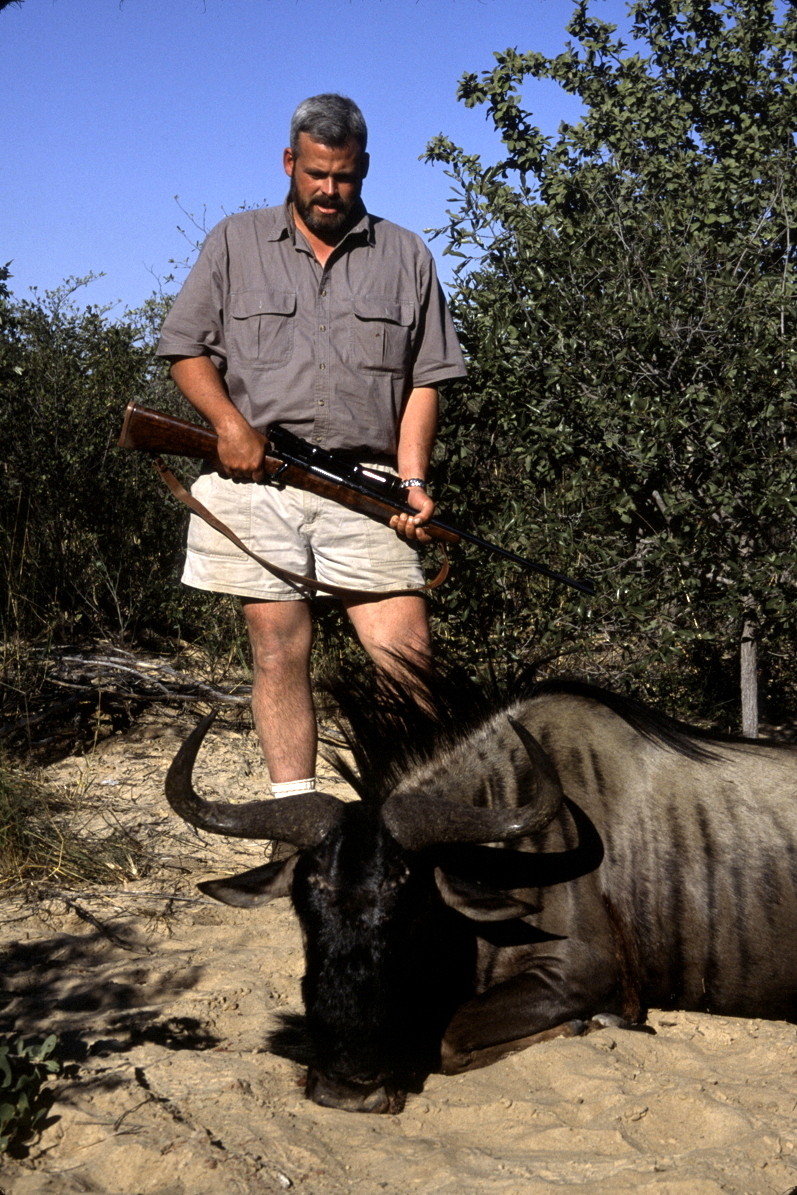 An Excellent Blue WildebeestSteve developed a passion for a massive blue wildebeest (or brindled gnu), the larger of the two species of wildebeest and the most widely distributed. These were silvery gray in color with bold dark stripes on the shoulders. We had seen their wallows in the roads for days but they hung to the thickest cover during the day. Only rarely had we glimpsed one. We were trudging down a long road toward a likely watering place when Steve caught a flash of silver and dove for cover with the rest of us following after. The bull stepped out only sixty yards away and Steve crawled out prone to take the shot. The bull took off like he'd only been stung, but he didn't get far before the X-Bullet did its work. See the action recorded as it happened here: Blue Wildebeest Hunt. |
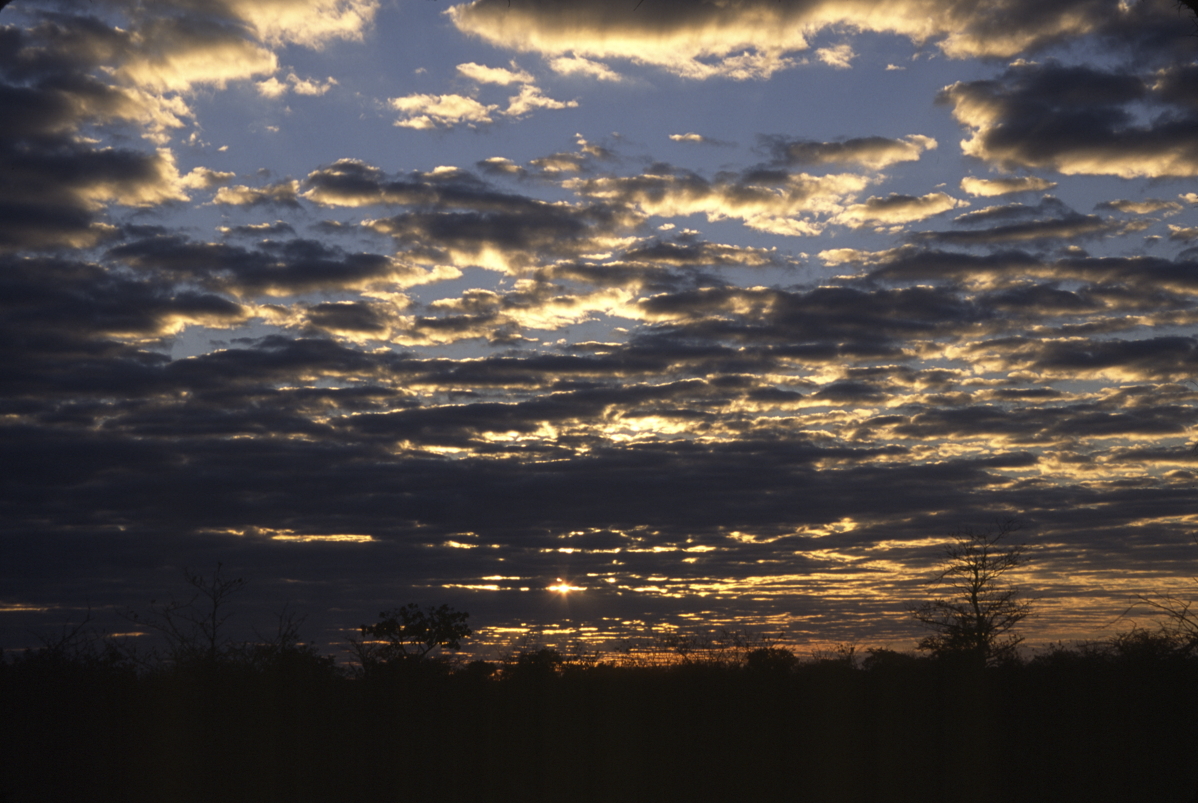 Dawn in WinterAfter days of cloudless sunshine, we awoke one morning to the first real indicator of winter. It remained nearly overcast until mid-morning and was cool and very blustery. |
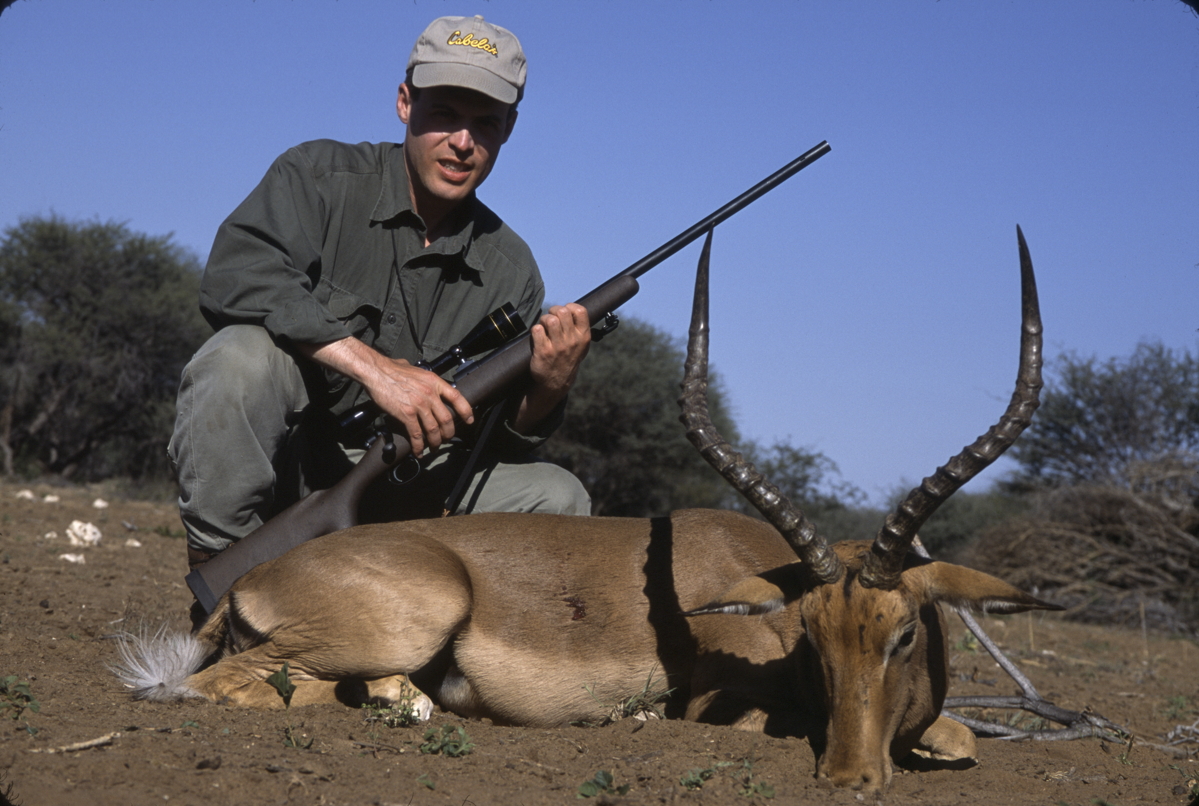 ImpalaI think that impala are among the most handsome of antelopes. Athough not originally native to this region, the Southern Impala has been introduced to parts of Namibia. The indigenous species, the Angolan or Black-Faced Impala, is endangered and where it can be hunted the trophy fees are about $2500. This 22 inch Southern Impala ram is enough for me. The .340 Bear Claw went diagonally across his thorax and dropped him in his tracks. Hunting these animals is exactly like stalk hunting whitetails in South Alabama except that the rams make a horrible gurgling growl to challenge one another which can betray their presence. |
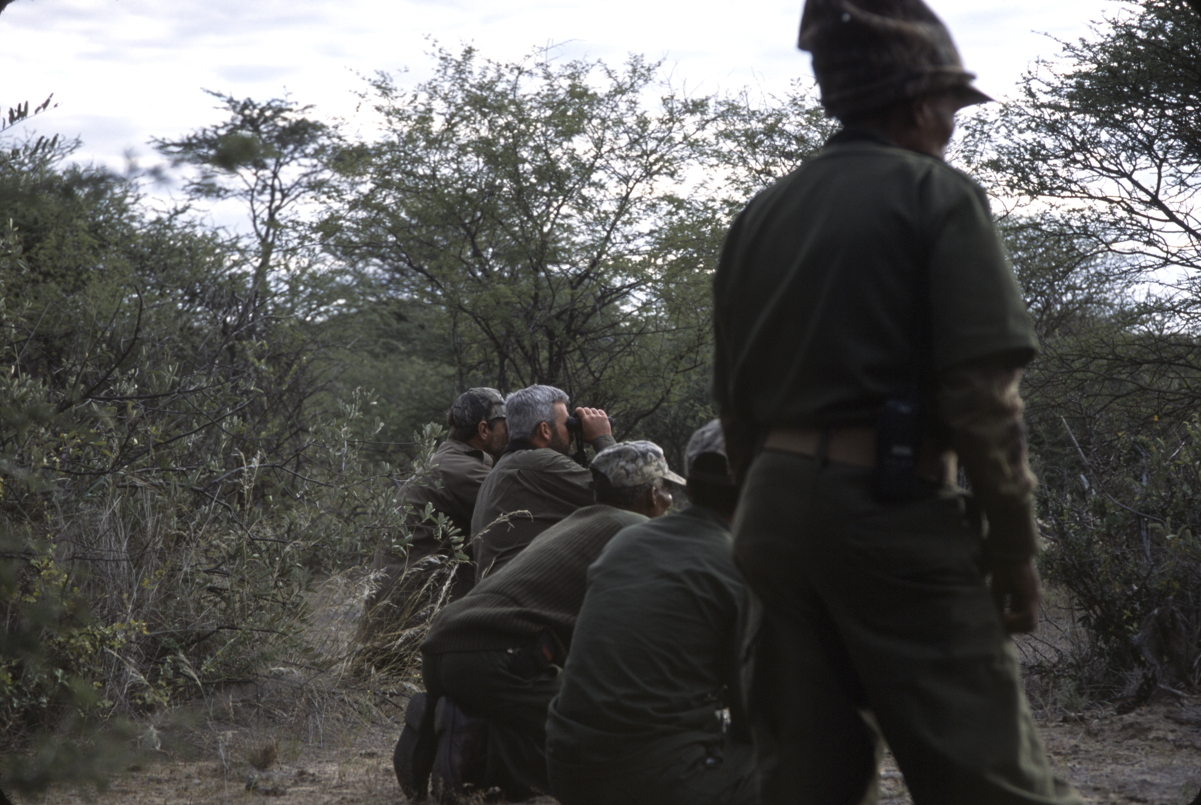
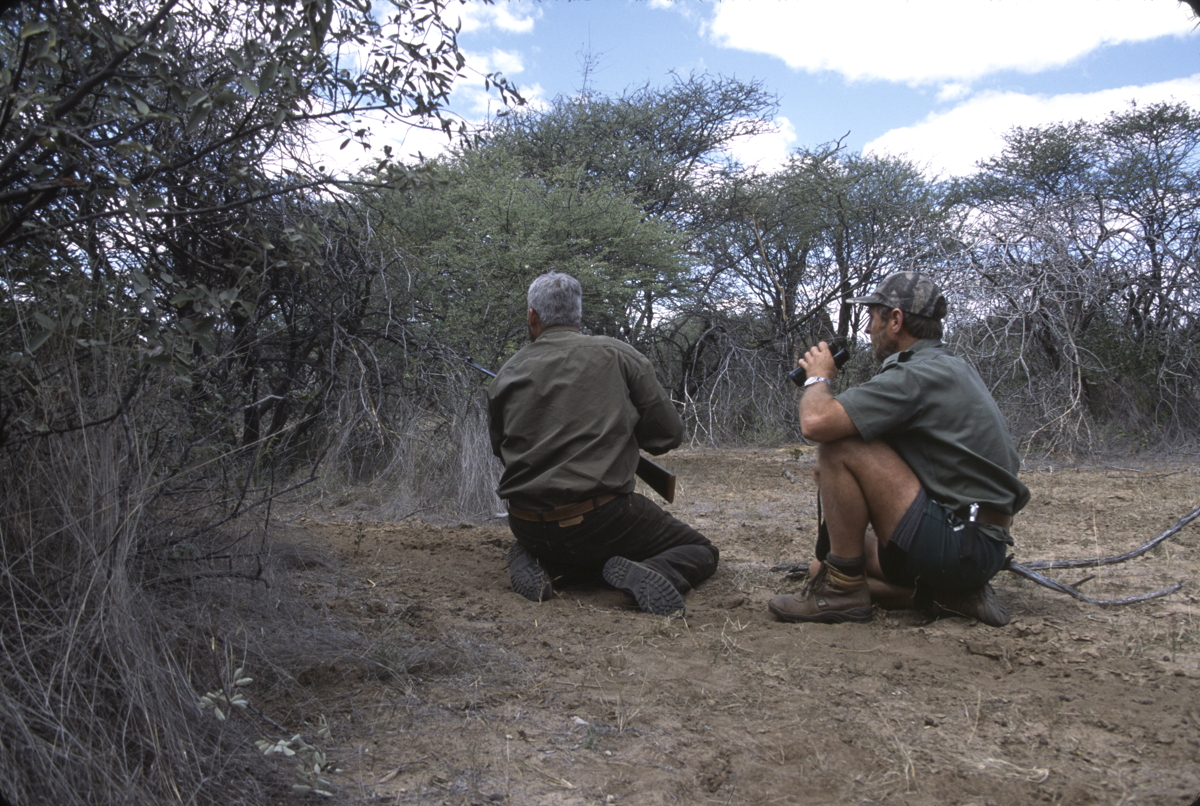 Stalking in the BushWe hunted in this thick stuff for a couple of days and it was my favorite experience of the safari. It reminded me of hunting back home. Slipping quietly through the bush, glassing for game and checking on waterholes is a great way to hunt. On the right, Steve prepares to take a shot (see below). |
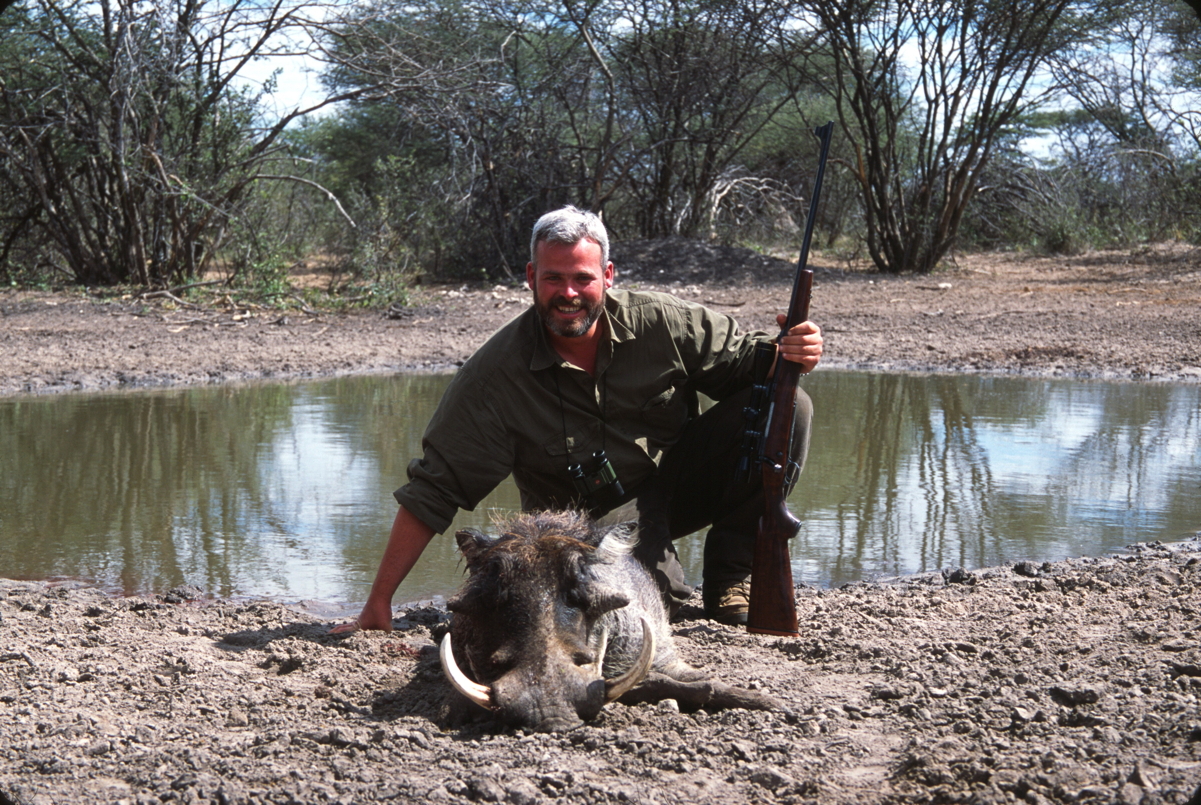
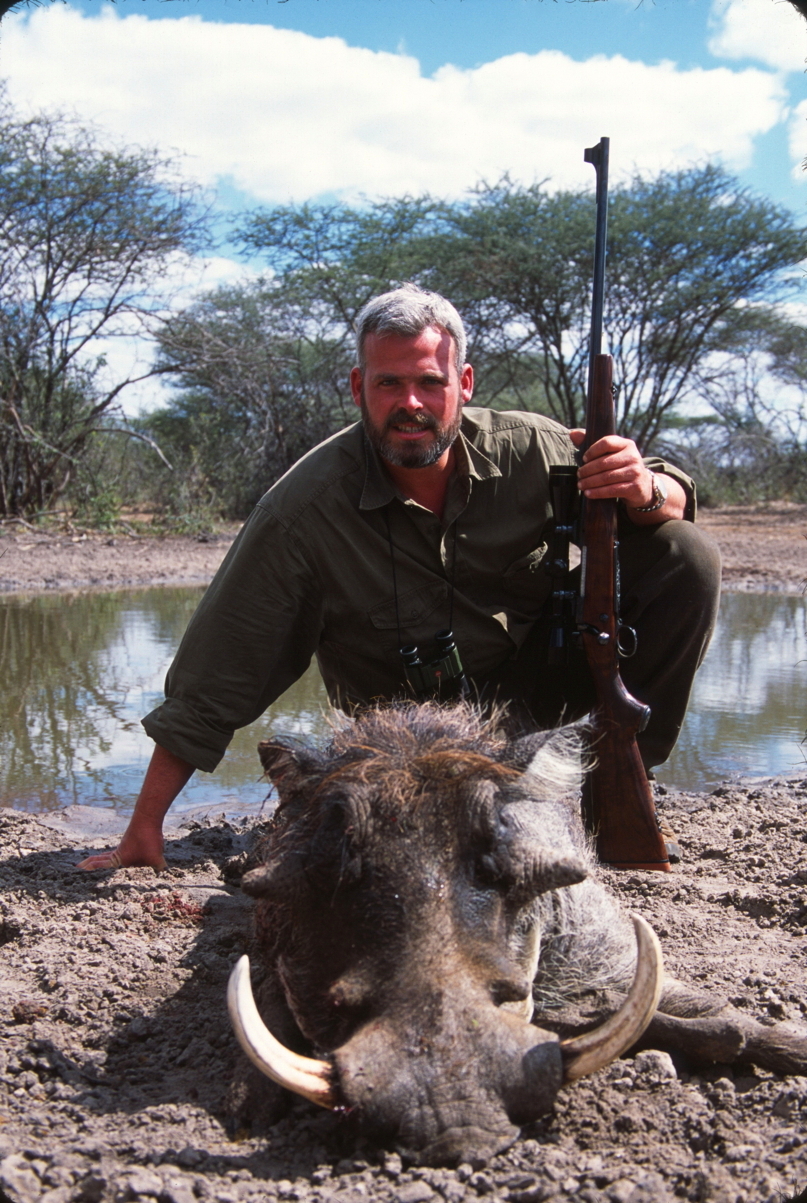 A Terrific Trophy TuskerThe last trophy sought by my brother was some real African ivory. Our budget did not accommodate a hunt for elephants, so we went in quest of a worthy warthog boar. Although we routinely observed sows with little ones in the Omataku River bed in the late afternoon, the big boars kept to themselves and the thicker cover, preferring to water just at dusk. This fellow proved an exception, as he came down mid-morning while we crouched in the cover beside a waterhole. The 200 grain X-Bullet struck some brush near the muzzle and hit the boar sideways, leaving a keyhole entrance lesion, but tumbled through the length of his body spelling a quick end. Those tushes are protruding over ten inches from either side, more than thirteen inches overall, and look at the spread! I think Steve was prouder of this last trophy than all the others. |
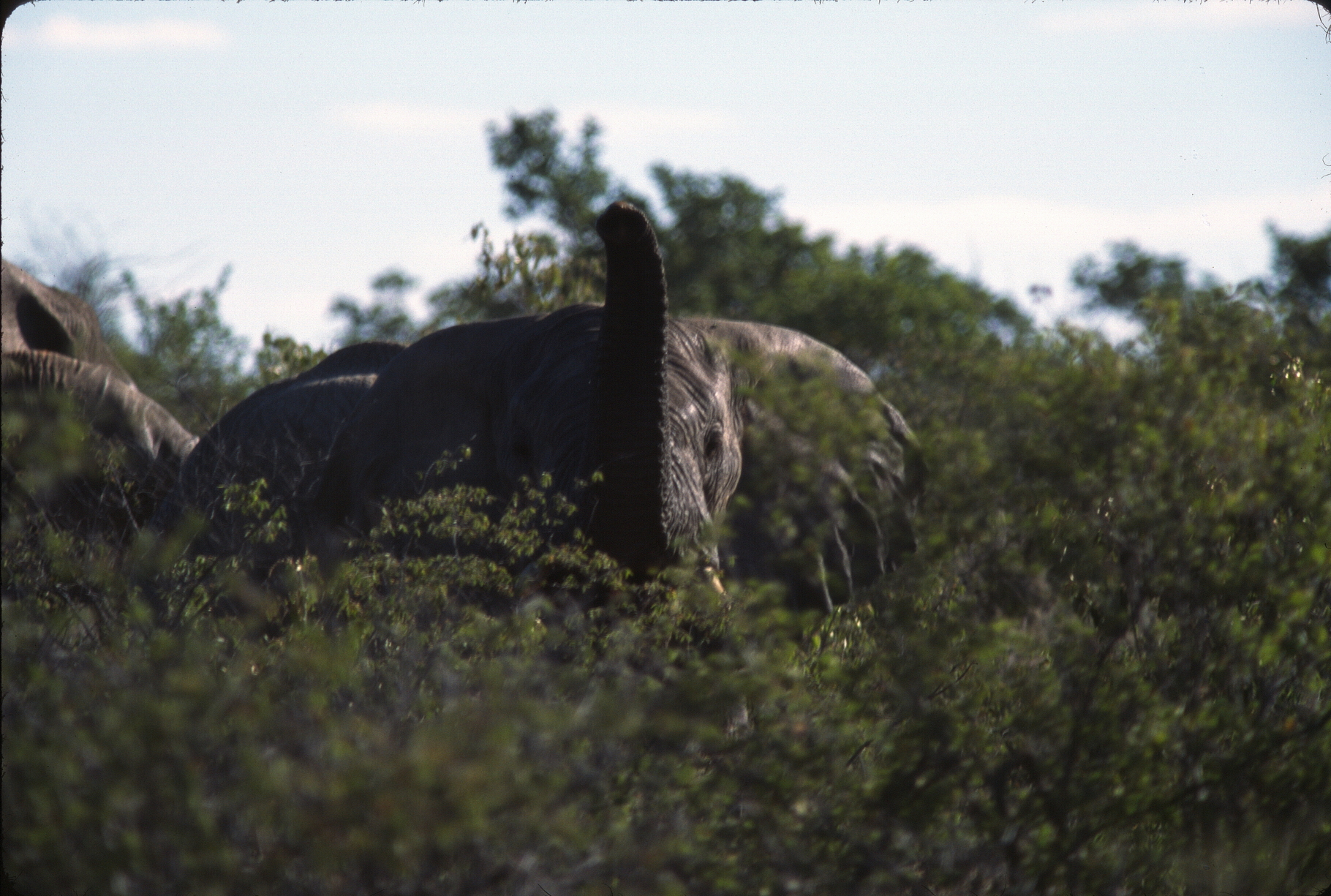
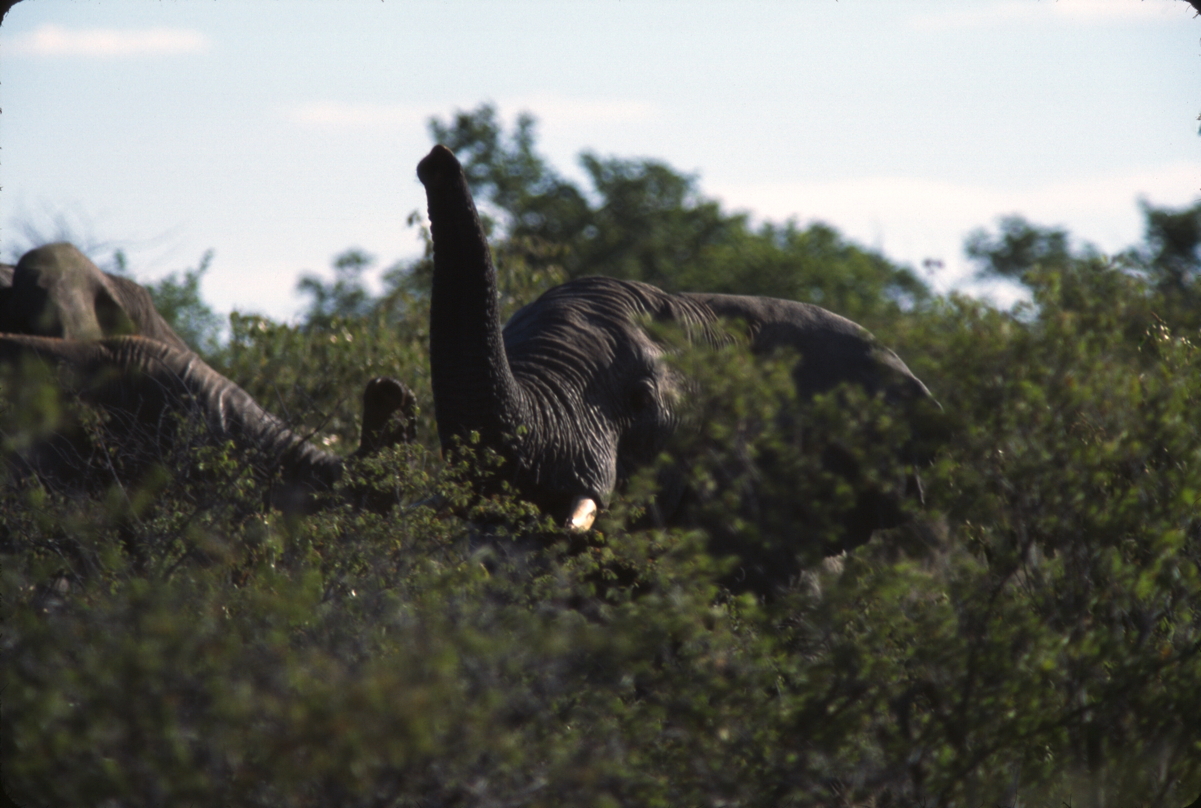
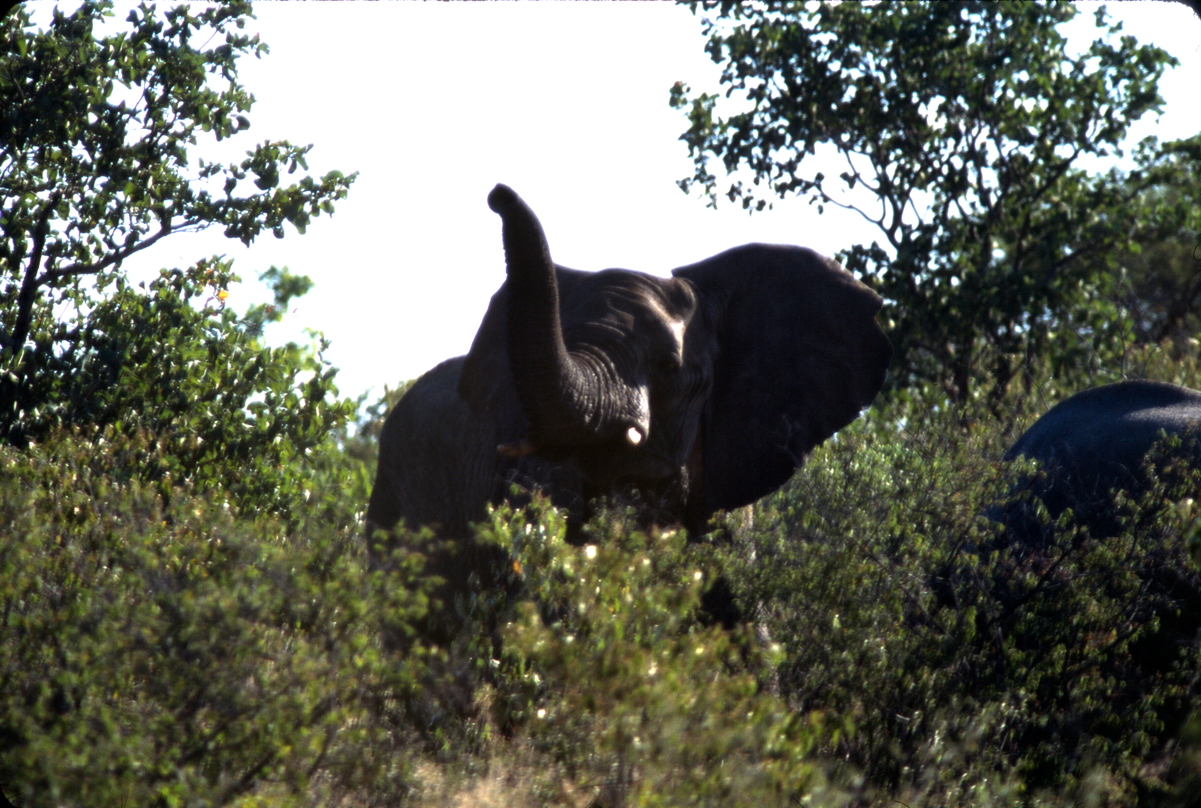 Elephants RampantOur hunting concluded, we took a photgraphic safari with our remaining time at Eden. These bad boys decided to wreck a bowhunting blind earlier that day (fortunately unoccupied). Imagine being inside when a herd of elephants went to tearing down your house! Although their tusks are very short, these pachyderms are still very big and capable of doing some serious mischief should the mood strike them. They towered above us even when sitting on the elevated seat on top of the truck. |
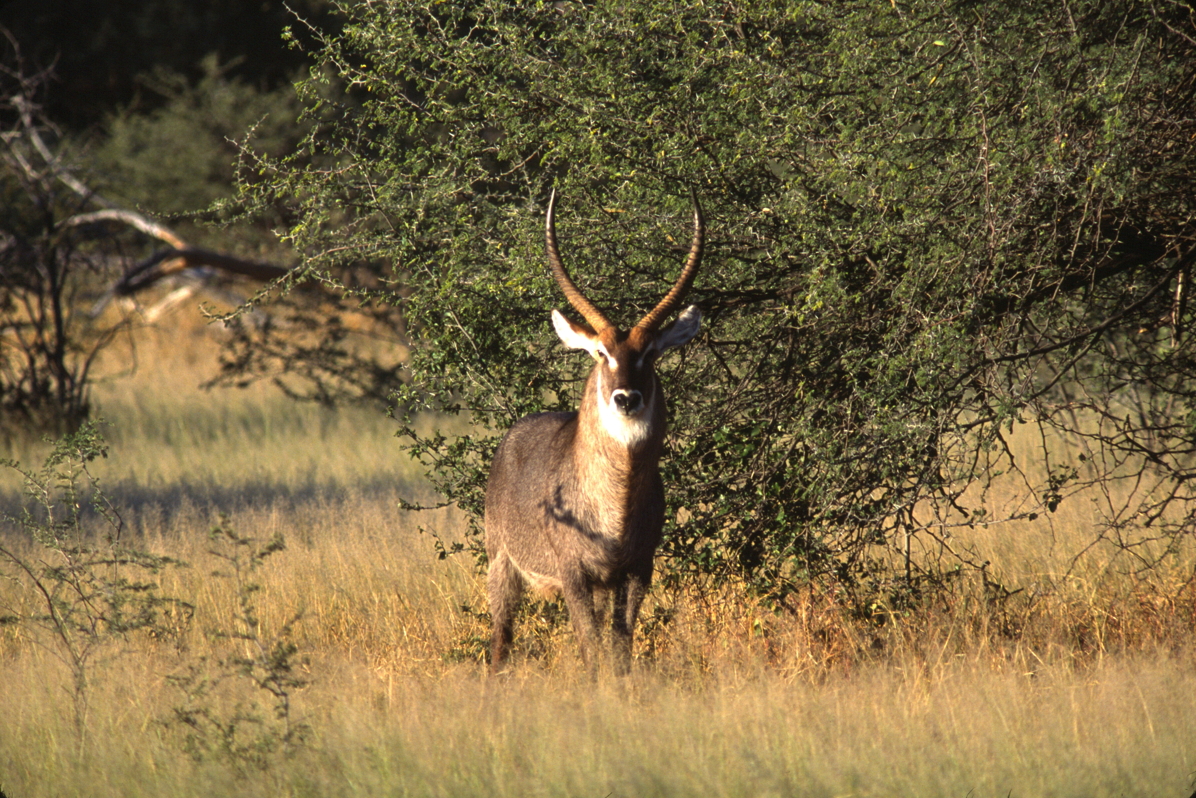 A Nice Defassa WaterbuckSince Allan doesn't permit any hunting in the area surrounding the camp, the animals along the Omataku River are not as wary of humans. They see activity every day and never hear a gunshot. But I think this old boy just liked to have his picture taken. |
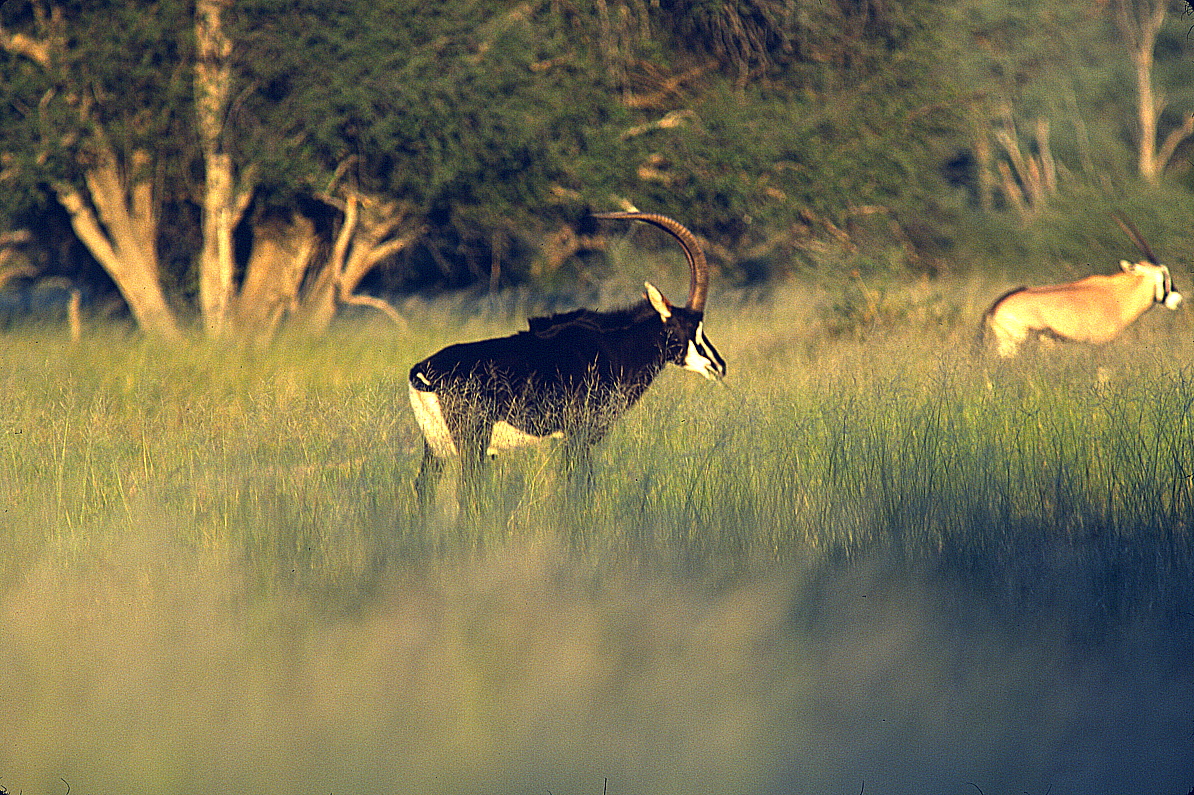
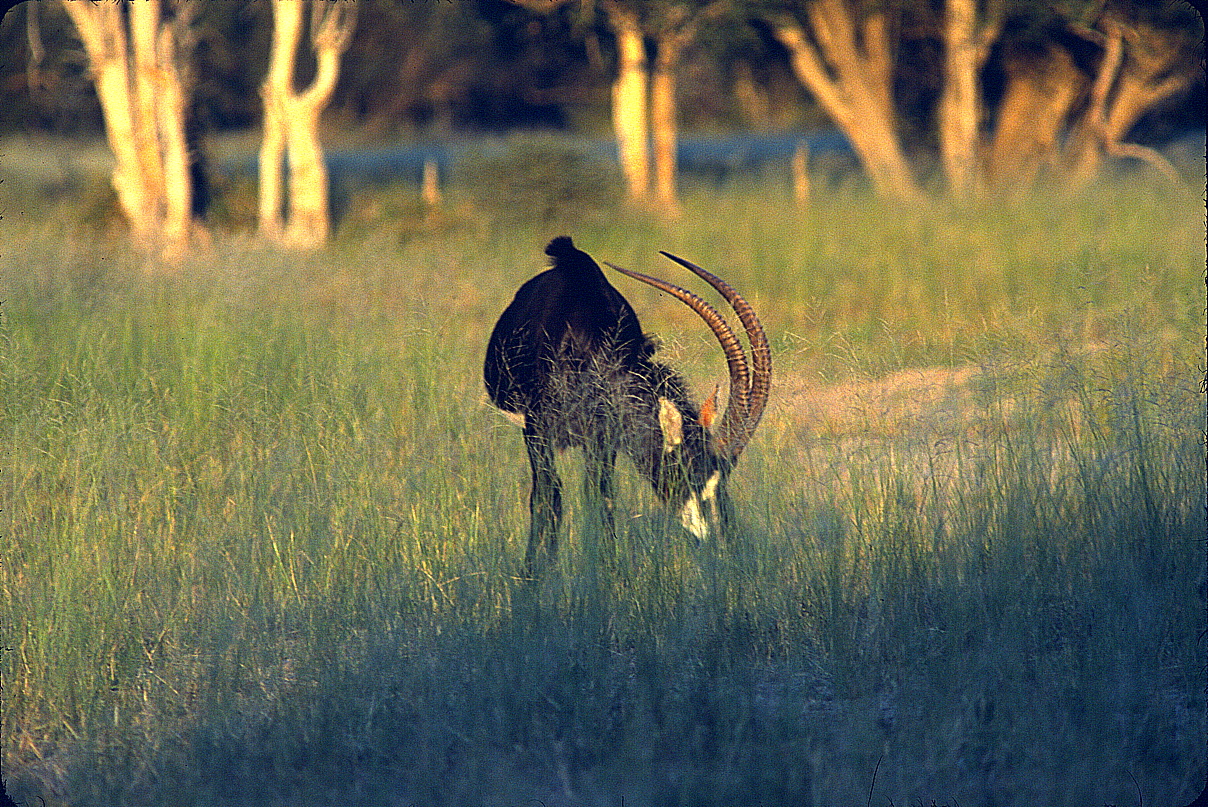 SableThis lone sable, a mature bull, was spotted while we were driving along the Omataku River back toward camp late one afternoon. I got down and stalked close to take photos with my camera while Steve filmed the action with his videocam from the truck. This was probably the highlight of the safari for me, to stalk within sixty or seventy yards of a trophy sable. Allan and Steve enjoyed it as well, making wisecracks about my stopping to look for mambas in the tree I used for cover (Allan had told us that the river bed area was "full of big mambas") and laughing at the bushmen's critiques of my stalking form. Unfortunately, I got caught up in the moment and forgot to bring more film, so I only got a few shots at very close range. This is another of the endangered species that lives within the Eden concession. |
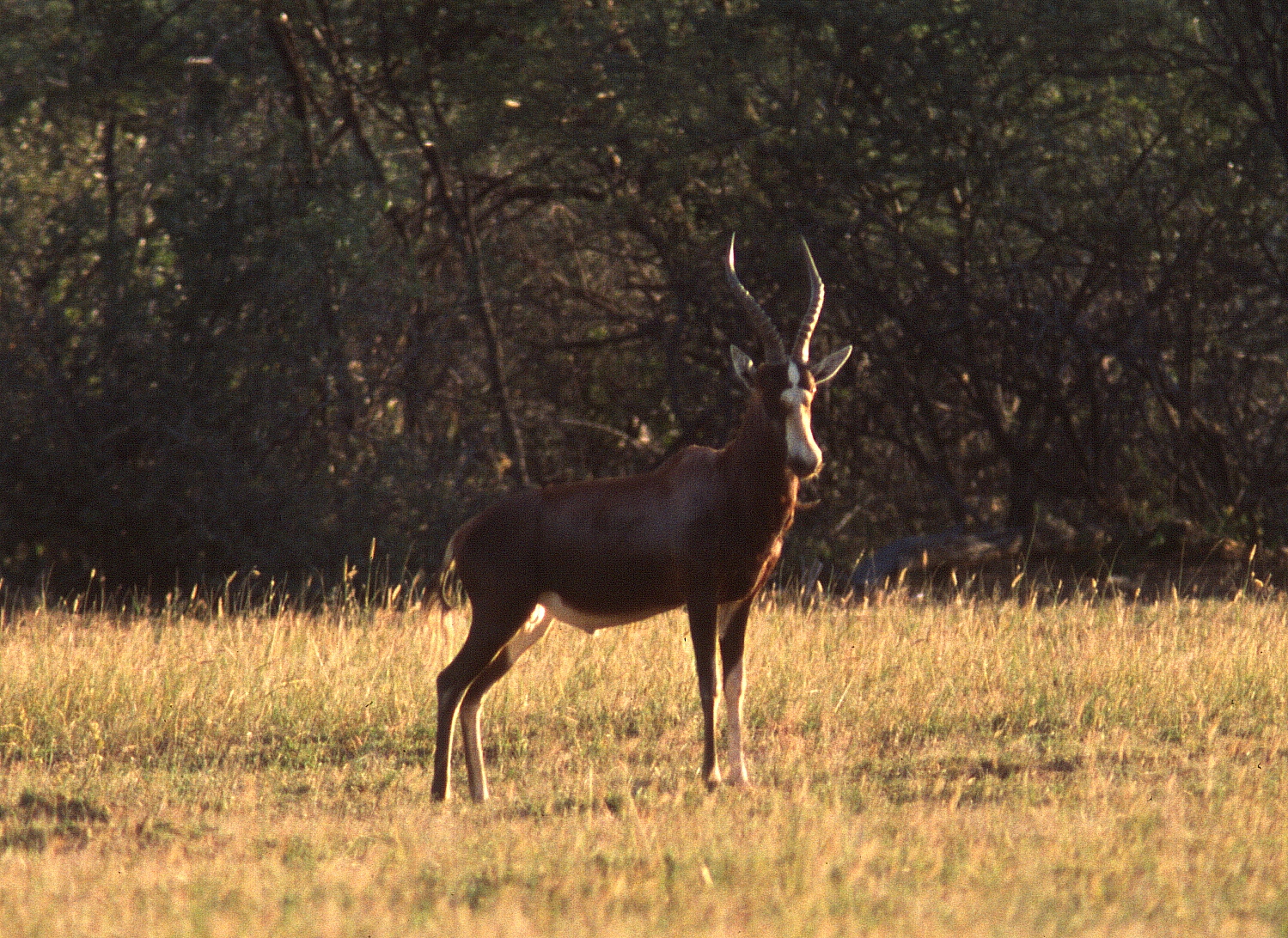 Blesbok RamI snapped this shot of a fine blesbok ram as we departed Eden. It somewhat makes up for my missed opportunity of the previous evening. Next time, Old boy! |
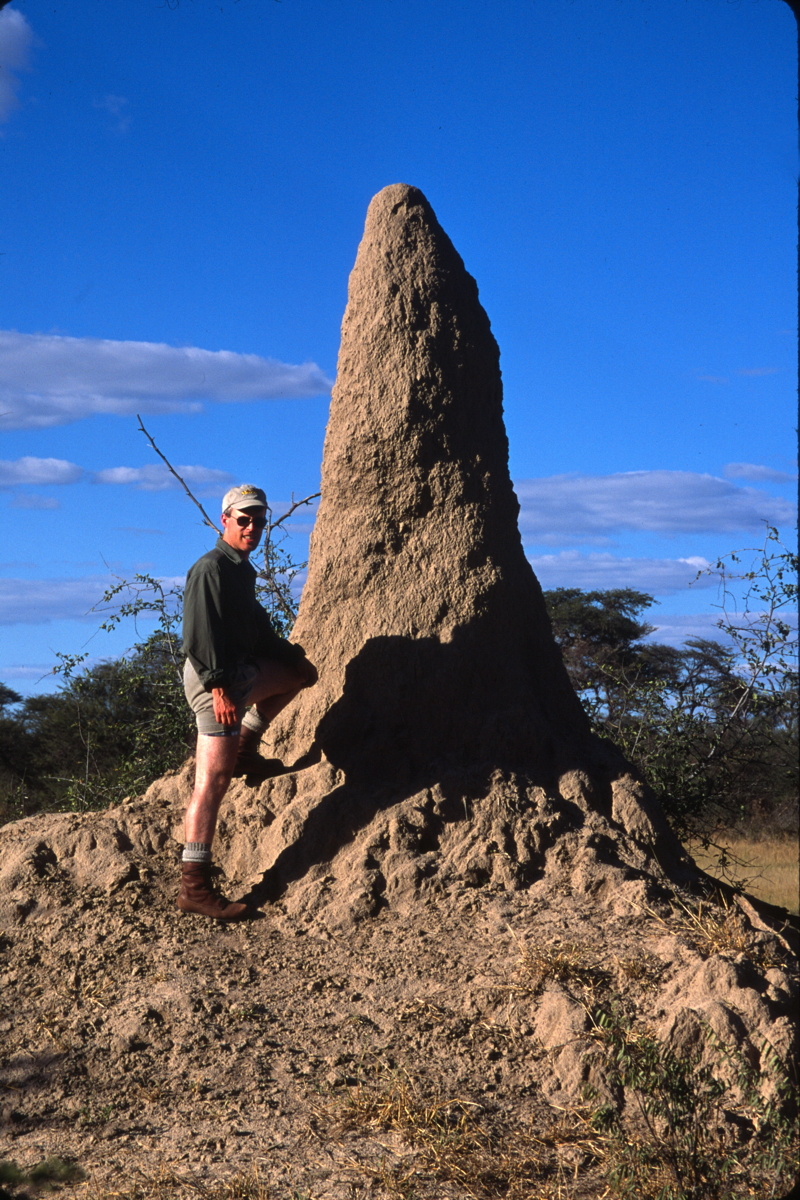 The Ant HillThe term "ant" in Southwest African parlance includes the 3/4 inch long, furiously industrious termites. I was aroused from my bed one night by a curious clicking sound and went outside with my flashlight to find the ground covered with big termites busily cutting straw with their nippers. This colossus was the tallest ant hill I ever saw and it stood right on the edge of our camp. |
Continue to: Etosha Pan National Park Photo Safari |
|
Copyright 2001 - 2013 -- All Rights Reserved |